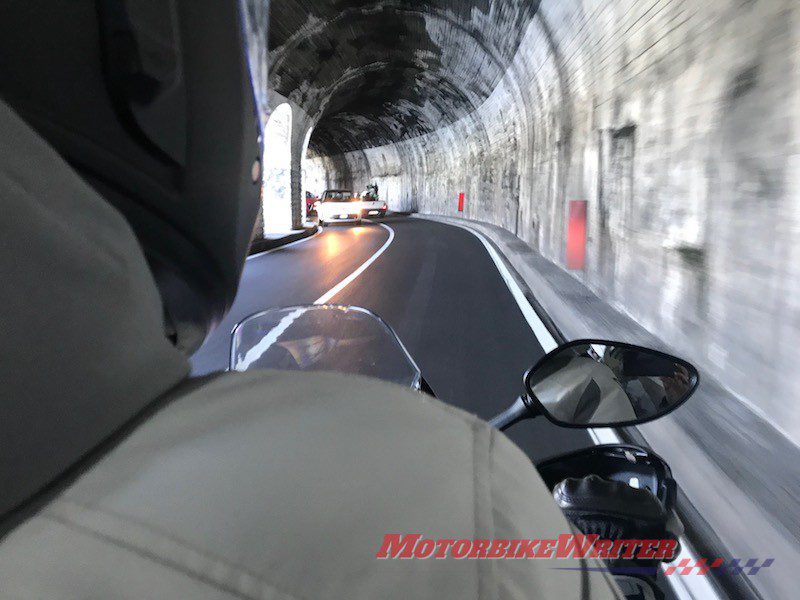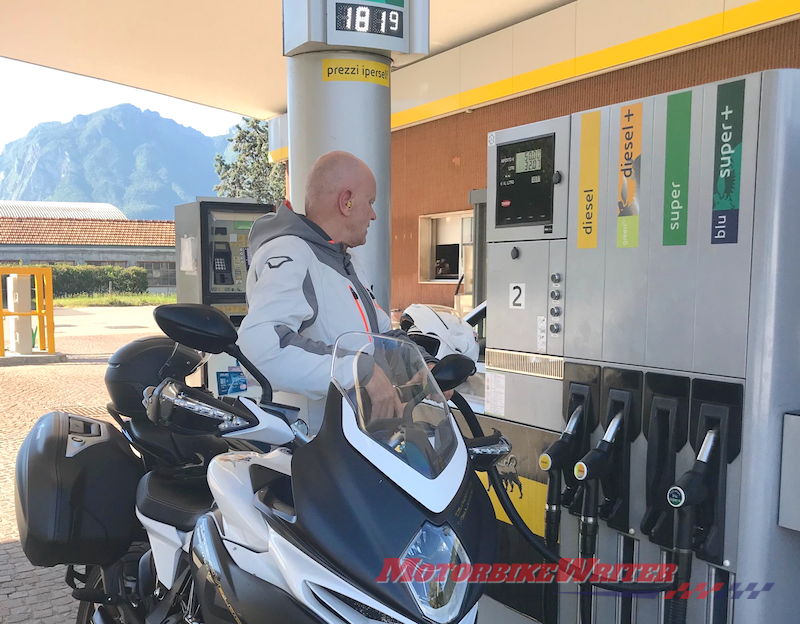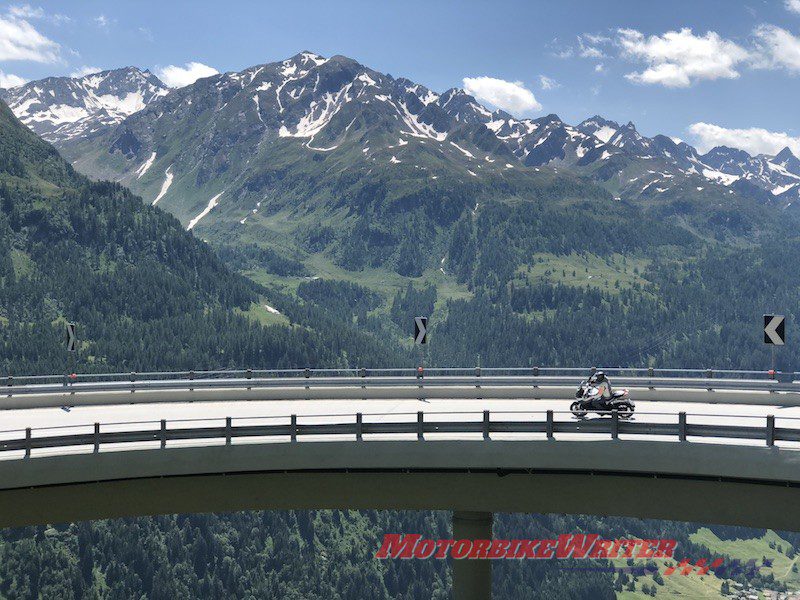Riding in Europe can be a delight, exhilaratingly fast, frustratingly slow, confusing, challenging and even expensive.
The continent is as big as Australia or the USA so there is a wide variety of road rules, climates and road types.
If you plan to travel through several countries in Europe, you should study the road rules, signs, taxes and even motoring behaviour of the countries before you go. Be aware that rules do change.
Failure to understand the rules could not only be dangerous, but also expensive, void your travel/bike insurance or void your bike’s warranty.
While the following is not an exhaustive list of the rules and regulations, we have provided some general tips here for enjoying your motorcycle tour of Europe. Do specific research on the countries you will visit before you leave home.
Licence
You’ll need an international driver’s licence if you are going to join an organised motorcycle tour or hire a bike. You can get them from auto clubs before you leave home.
If you own the bike, you may be able to get away with your normal licence.
Make sure you carry your licences and your passport with you in case you are pulled over by the police or border control.
Immigration control can vary from being so lax you don’t know you’ve crossed a border to thorough searches of your panniers and documents.
You should also carry proof of vehicle ownership, insurance details and even your return airflight details, especially for some border crossings.

Weather
Bring wet gear, because it will rain!
Like New Zealand, weather can change quickly in time and location.
If it’s raining in the valley you are in, it may be clear just over the hill.
Even in summer the roads can be icy in the alps and northern Europe especially around early morning and late afternoon or all day on the shady side of mountains.
Continue reading this article about travelling to Denmark.
Navigation
You will need satnav as the road networks can be complex. Paper maps may be helpful for planning a route, but you will need turn-by-turn navigation to negotiate the myriad roundabouts.
If you don’t have a dedicated GPS, you can use your phone as a GPS with a local SIM card as the phone signals in Europe are pretty comprehensive. A 5GB data SIM will cost about €25 and last a month if you just use it for navigation.
Get to know the road signs which are complex. Some even tell you when you can and cannot pass!
Roads
Avoid Motorways, Autobahn, Autoroute or Autostrada. They often have tolls, the traffic is heavy and fast, and there is a lot of traffic turbulence at high speed for motorcycles.
They are great for getting from one place to another quickly or for testing out the top speed of your bike, but they are not very enjoyable. The high speed can be fatiguing and quickly drain your fuel tank.
Driving on these multi-lane roads is ordered; even regimented in Germany! You should stay out of the left lane unless you are passing and as soon as you pass, you should move over. If you don’t, you may find a vehicle right up your tailpipe, blowing the horn or flashing their lights for you to move right.
Don’t be fooled into thinking motorcycles will be the fastest traffic or that a Citroen bread van is not quick! You can be passed by a variety of vehicles.
Police patrol the highways, not for speeding but mainly for motorists who do not allow others to pass or for underpassing (passing on the right) than for speeding!
Unless you know what you are doing on these roads, stay out of left lane!
Stick to national, state, country and provincial roads. These are more scenic and often follow old trade routes so they are winding and fun.
Be aware that they can suddenly go through a village with speed limits as low as 30km/h and some can be unpaved or have cobble stones which play havoc with 17-inch front wheels.
Taxes
It can be expensive riding around Europe because of tolls and special taxes, but at least you can park free just about anywhere, including many footpaths.
While parking rules vary from town to town, the best plan is to park where other motorcycles and scooters are parked. Just be aware in some residential areas that only residents can park.
Make sure you don’t obstruct pedestrians or block footpaths.
Most countries have toll roads, so carry small change.
There is no point getting a transponder because they don’t work across borders, which is strange for the EU.
Southern and eastern European countries have the most tolls and the worst roads, while there are none in Germany which has the best quality roads.
If you plan to use the motorways, you will need to buy a vignette which is a sticker you place on your bike.
Here are the prices:
- Austria: 10 days, €8; two months, €23.4; one year €77.8
- Bulgaria: 7 days, €5; one month, €13; one year €34
- Czech Republic: 10 days, CZK 310; one month CZK 440; one year CZK 1500
- Hungary: 7 days, HUF 2975; one month, HUF 4,780; one year HUF 42,890
- Romania: 7 days, €3; one month, €7; one year €77.8
- Slovakia: 10 days, €10; one month, €14; three months, €13, one year, €28.
- Slovenia: One week, €15; one month, €30; one year, €95.
- Switzerland: One year, CHF 40.
Police cars have technology to detect the presence of these stickers even at highway speeds. Fines can be hefty.
You will also need a green zone sticker for low-emissions zones in some big cities in France, Germany, Denmark and Austria. Click here for more details.
Motorcycles are exempt from London’s Low Emissions Zone, but from April 2019 the Ultra Low Emissions Zone will charge a £12.50 a day for motorcycles that do not meet Euro 3 emissions standards.
Lane filtering and lane splitting
Lane filtering is generally considered to be riding between lanes of slow-moving traffic. However, some European countries also allow lane splitting at higher speeds.
In these countries it is not only allowed, but expected. You may even be honked if you are taking up a space in the queue of traffic rather than filtering to the front!
Many roads are narrow, so passing can be difficult. However, drivers will often pull over for you to pass as many European teens started their motoring life on a scooter.
On some roads with one lane each way, you can still ride up the middle even when there is oncoming traffic.
You can be more adventurous in southern European countries, but be more cautious in France and Switzerland.
Speeding
Speed cameras are used throughout Europe, especially the UK. Switzerland is very tough on speeding, especially in their tunnels.
Fines can be quite expensive. Some countries such as Finland even link speeding fines to your wages! So if you are rich, it could be quite expensive. The Swiss police have also been known to lock up excessive speeders and impound their vehicles.
Some countries can be more lenient on riders “having a go”. I was given the “slow down” wave by the Polizia as I descended the Stelvio Pass in a hurry, but as I went past, he smiled and gave me the thumb’s up! Make of that what you will.
Speed limits are in km/h on the Continent where they drive on the right and mph in Britain where they drive on the left.
Maximum allowed Continent speeds, unless otherwise indicated, are:
- 130 km/h (80.78 mph) on Autostrada/motorways (Germany has a few autobahns with no speed limit in the left lane);
- 110 km/h (68.35 mph) on main roads outside built-up areas
- 90 km/h (55.92 mph) on secondary roads and local roads outside built-up areas
- 50 km/h (31.07 mph) in built-up areas; a speed limit of 70 km/h (43.498 mph) can be indicated on some main urban roads
- Note: In bad weather conditions, the maximum speed is 110 km/h (68.354 mph) on motorways and 90 km/h (55.92 mph) on roads outside built-up areas. These are often controlled by electronic speed signs.
- In winter, some countries drop their speed limits by 20km/h, but it is not signposted.
- In the UK, the national speed limit is 70mph (112km/h) on motorways and dual carriageways, 60mph (96km/h) on single carriageways and generally 30mph (48km/h) in areas with street lighting (restricted roads).
Fuel
Fuel will cost about twice what it is in Australia.
Most petrol stations have automatic bowsers. They will take notes and credit cards and you can fill up without having to take off your helmet. Use an approved overseas credit card, preferably one without international transaction fees. I actually use cash because I’m concerned about “skimmers”.
Some petrol service stations are manned with a pump operator who will fill your tank, although not during mid-afternoon siesta.
You will have to instruct the operator on the type of fuel and how much is required and they will often not give you a receipt. You are allowed to keep your helmet on and sit on your bike while it is being filled unless instructed otherwise.
Rules and regulations
There are some bizarre rules and regulations in various countries in Europe.
Most riders wear a lot of fluorescent colours on their jackets and helmets because of the poor visibility conditions they can encounter. But in France it is mandatory and you can cop an on-the-spot fine of €11.
If you rent a bike, be aware that there are some places you may not ride, such as around the Arc de Triomphe in Paris.
You must use your indicators for entering and leaving roundabouts, changing lanes and overtaking. Although in southern European countries indicators are rarely used.
Be aware that some roundabouts in Paris have opposite give-way rules where entering traffic has right of way over traffic on the roundabout. This is slowly changing, so it’s best to observe what the traffic is doing before entering the roundabout.
Around the Arc de Triomphe, the multi lanes of roundabout traffic give way to entering traffic which must go straight to the centre of the roundabout. It’s crazy!
In some countries, there is a zero alcohol tolerance, especially for newly licensed riders or those under 21/22. In most the blood alcohol content limit is 0.05.
You must also carry a simple first-aid kit in some countries.










